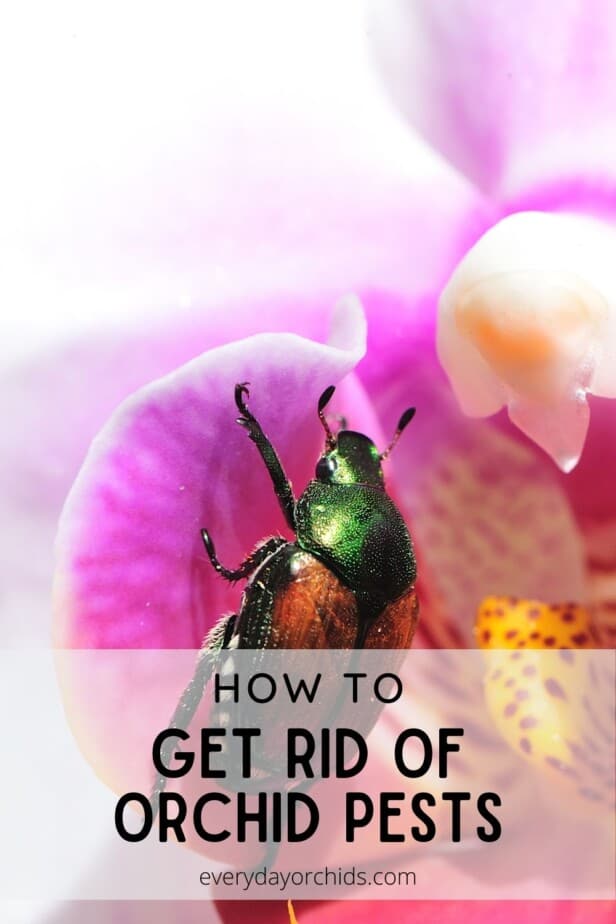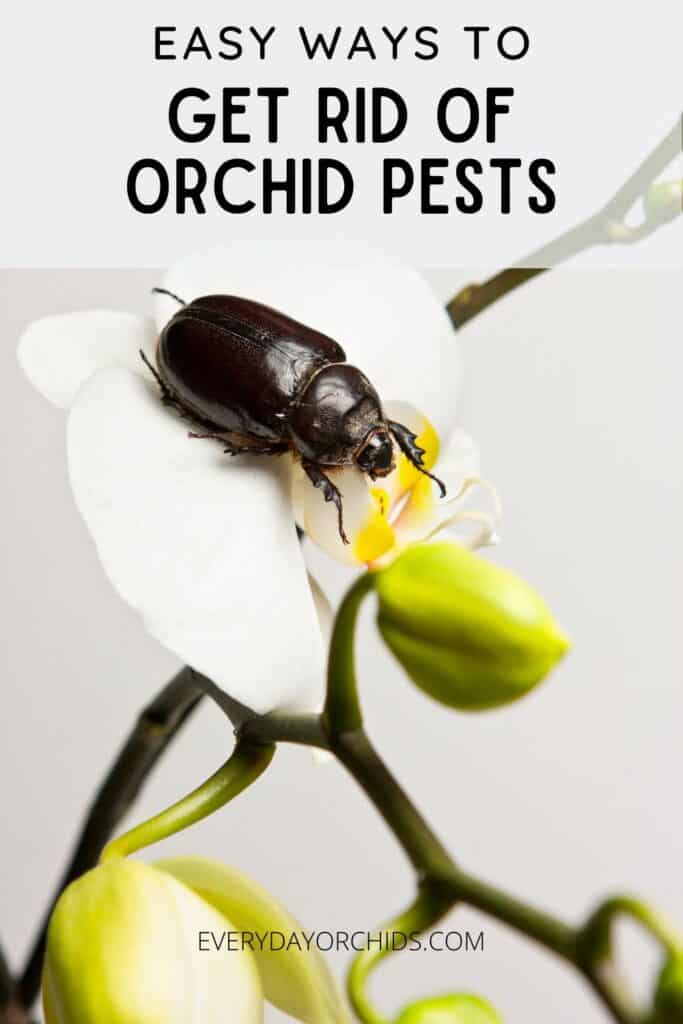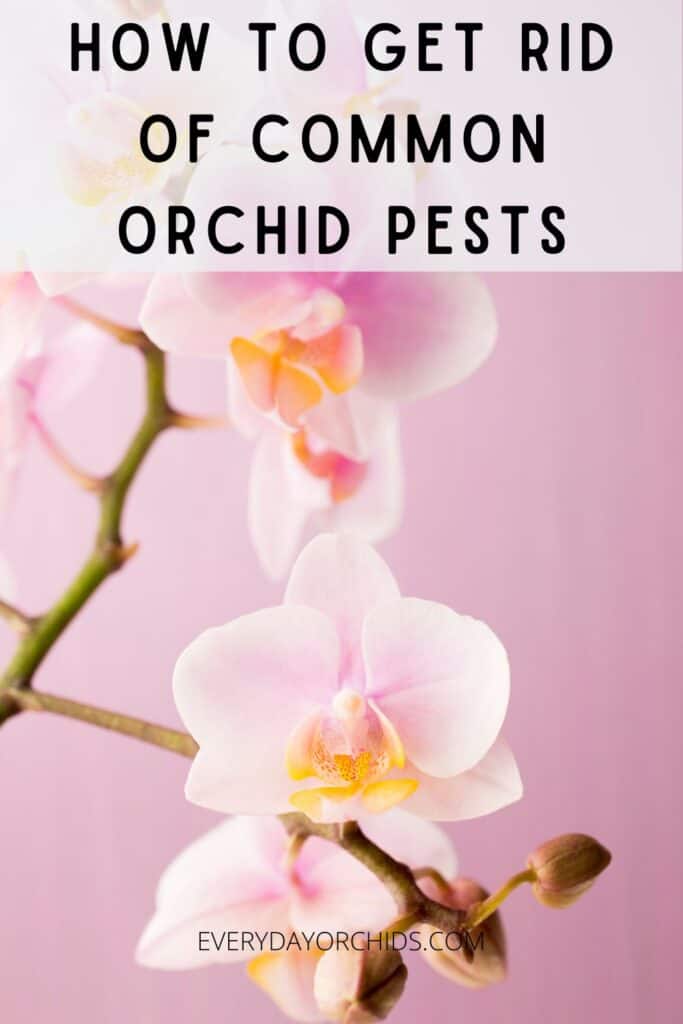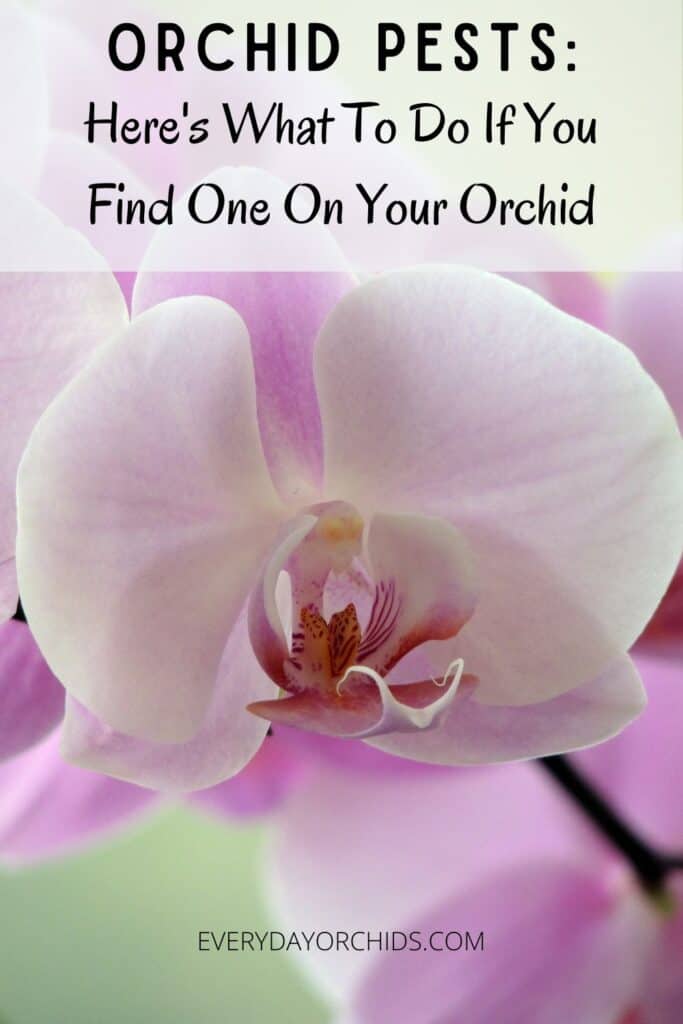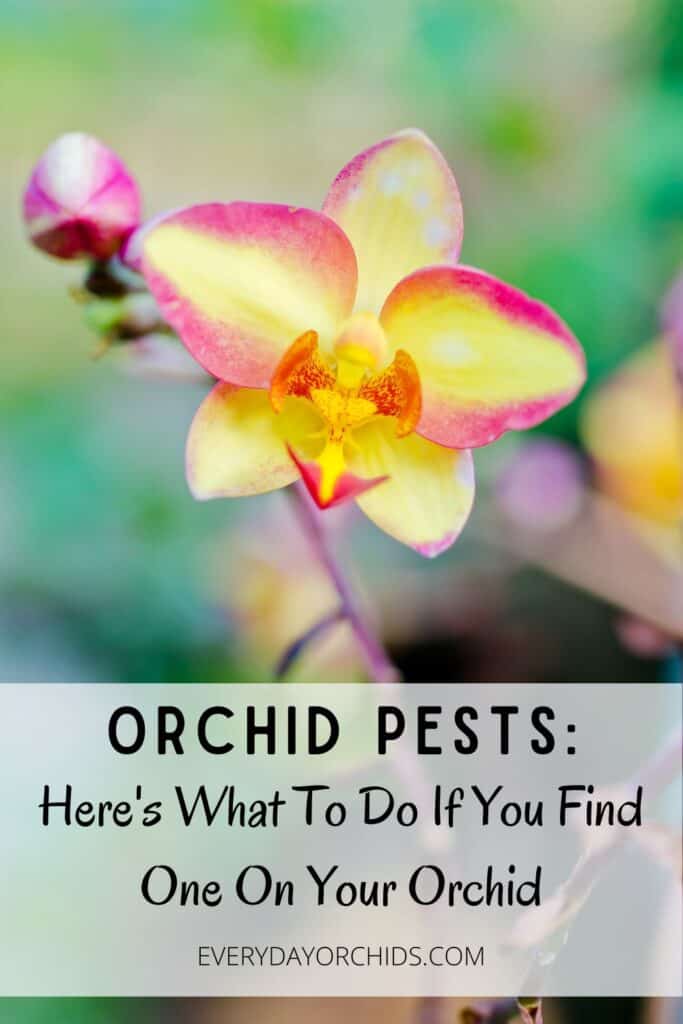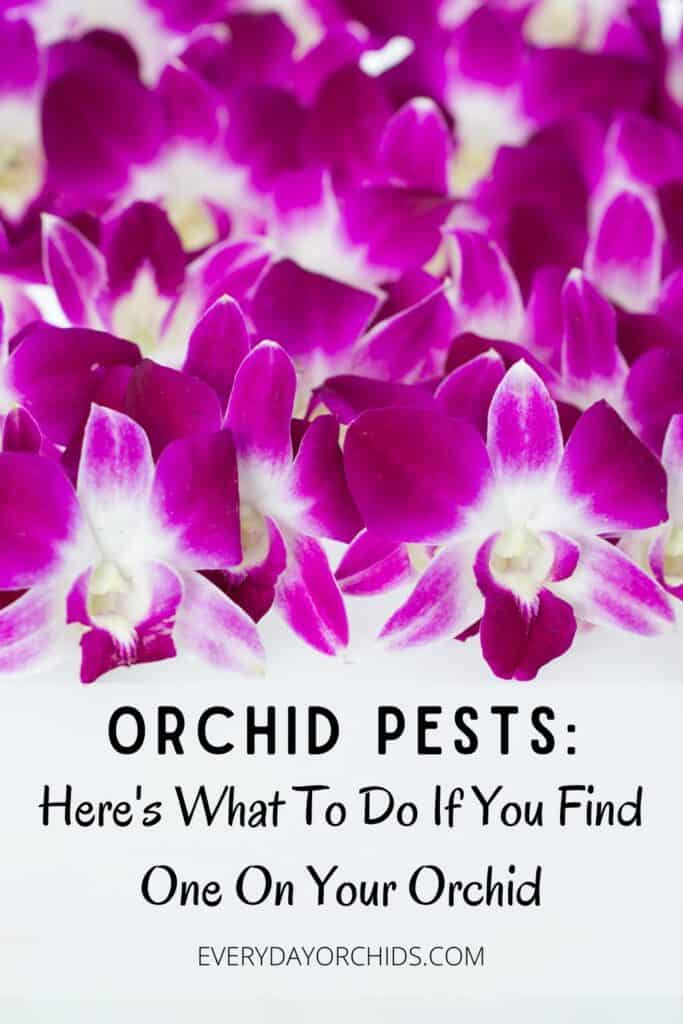Do you have an orchid pests on your orchid? Whether you have been growing orchids for years or are just learning to take care of your first orchid, nothing is more upsetting than discovering a pest infestation on your orchid.
If left untreated, these orchid pests can destroy all of your hard work cultivating these beautiful plants. So how do you deal with a pest infestation on your orchid?
You can get rid of white bugs and other orchid pests with warm water, rubbing alcohol, pesticides, or biological means like predatory bugs. The method you use will depend on the type and severity of the infestation. Any method you use must be applied consistently to ensure both mature and newly hatched pests are killed.
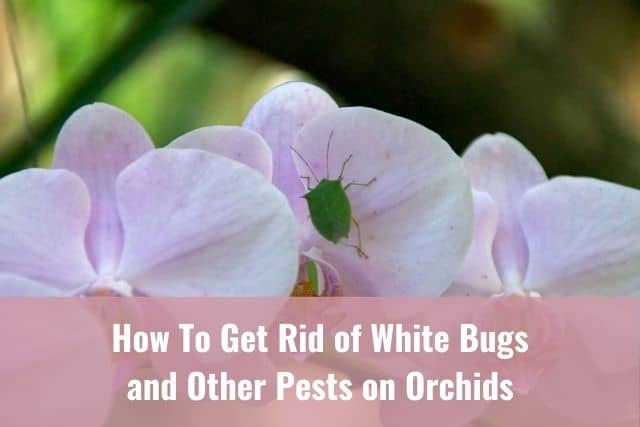
Let’s take a closer look at some of the most common orchid pests, including how to identify them. I’ll go over what causes orchid pest infestations and how to treat them. Keep reading to learn more about how to deal with pests on your orchid plants.
Please note that these links are affiliate links and as an Amazon Associate, I earn from qualifying purchases. Purchases made through affiliate links in this post may generate commissions at no additional cost to you. Use this link for a free or discounted Amazon Prime trial. Thank you for your support!
Table of Contents
Why Orchids Are Vulnerable to Pests
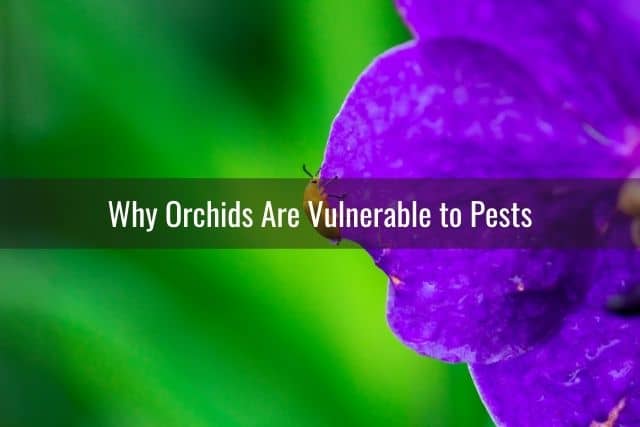
It is frustrating and sometimes nerve-wracking to discover pests on your orchids, especially when you have taken all the necessary steps to ensure their health.
Orchids grow in the summer, which, unfortunately, is also the season in which pests tend to thrive. Just as an orchid’s growth season tends to happen during warmer weather, you will also find more destructive pests during the summer. Even though these flowers are known for their hardiness, an untreated pest infestation can take them down.
Chances are you have not done anything wrong to cause an infestation. There is a possibility bugs were present when you bought your plants. The thing is, once orchid pests infest one orchid, they will then move from plant to plant until the entire collection is affected.
Luckily, most orchid pests’ treatment is fairly similar. You can likely treat different pest infestations all at once. Let’s dive deeper into some of these common orchid pests and how they can be treated.
How To Get Rid of Orchid Aphids
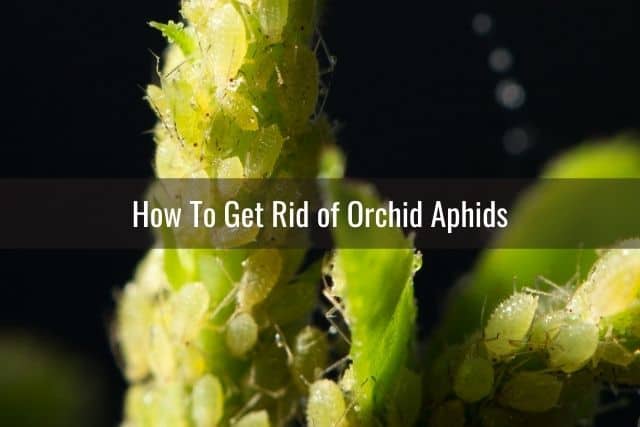
Aphids are small, sap-sucking insects that can wreak absolute havoc on orchids if left untreated. Fortunately, they should be pretty easy to spot.
Identification Of These Orchid Pests
If your orchid plants have started to look shriveled and yellow or are curling at the leaves, check the underside of the leaves. Look for pear-shaped, quarter-inch long bugs. These are aphids.
You will likely find them on the underside of orchid leaves. They can also be spotted around the flower and flower spikes where there is growth.
Aphids are bad news for your plant for several reasons. Not only will they spread from plant to plant, but they will also do so incredibly quickly. Aphids reproduce at a rate of several generations a season. By the time you see your first bug, you are probably dealing with an infestation.
Aphids shed white skins as they develop. Look for a pile of white flakes on the upper leaves of your plant. This may be the first sign of an infestation.
Aphids quite literally suck the nutrients out of orchids, preventing them from growing. Furthermore, they excrete honeydew that can cause damaging fungi to grow and attract ants.
Ants will feed on this honeydew and even farm it, moving it from plant to plant. This travel between plants speeds up the spread of the infestation until every plant in the garden is affected.
Causes
Aphid infestations are usually a result of purchasing an infested plant. Orchids grown indoors or in greenhouses are more susceptible to aphids than those growing outside in tropical regions.
Air currents from fans help spread the pests. As colonies become larger, winged aphids will develop and begin flying from plant to plant to build new colonies.
Treatment
You can usually get rid of aphids with a few simple methods.
For smaller colonies, or if the infestation is relatively new, you may be able to take care of the problem with just water. Simply hose down your plant, focusing on the undersides of the leaves. Do this every few days for up to two weeks.
You can also add a neem oil spray or insecticidal spray. Spray the leaves with a high-pressure spray bottle.
However, if the colony is large and well-established, you will need to use slightly more aggressive methods. These include:
- Chemical Insecticides: Insecticides that contain permethrin, acephate, or malathion should all take care of the infestation. Make sure to follow the product’s instructions for mixing and application. Products containing imidacloprid are another great option. These products will kill aphids but not hurt pollinators like butterflies, bees, and hummingbirds.
- Horticultural Oils: If you are looking for a more natural approach, consider using a horticultural oil such as neem oil. These do not contain harsh chemicals and instead coat and suffocate the aphids.
- Ladybugs: Introducing aphid-eating ladybugs to your plant is another chemical-free way to get rid of the infestation. You will have to get your hands on some ladybugs, which can be purchased at some garden centers or online. It might be fun to see these critters in your garden every day.
How To Get Rid of Orchid Mealybugs
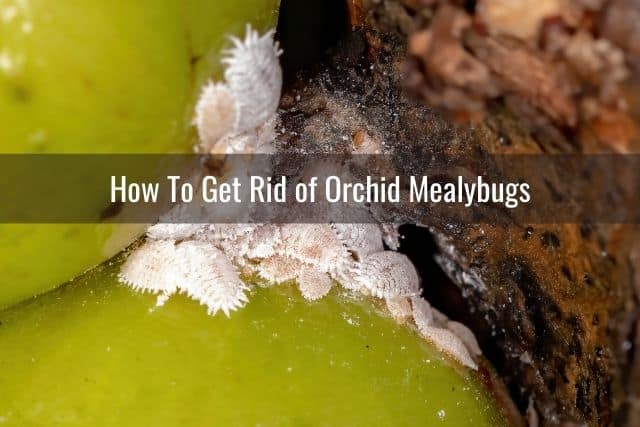
Like aphids, mealybugs are incredibly damaging to orchids. As soon as you identify these orchid pests, you’ll want to start taking steps right away to get rid of them.
Identification Of These Orchid Pests
You will see many of the same symptoms in your plant – drooping, yellowed leaves – as you would with aphids. However, mealybugs are much harder to identify.
Mealybugs tend to hide in a plant’s crevices, concentrating on tender, nutrient-rich new growth areas like buds and roots. By the time you see what looks like white fuzz on your orchid leaves, a mealybug infestation is already in full swing.
The damage mealybugs cause is most similar to scale bugs, which we will take a further look at later. Like all white bugs, however, these sucking insects rob orchids of all their nutrients and vigor. If left untreated, the plant will likely die.
As with aphids, mealybugs leave behind large amounts of honeydew. This leads to sooty mold and attracts ants, further compounding the problem.
Causes
Mealybug infestations are typically the result of the purchase of an infected plant. Mealybugs are incredibly active bugs and have been known to hide under the lips of plant pots. This makes them even harder to find, increasing the chances that you will bring an infected plant into your home.
Furthermore, young mealybugs are airborne. With circulating air indoors or even strong winds outside, these pests will travel to new plants and form new colonies.
Treatment
Using soap and water is a possible treatment if you have been lucky to spot a mealybug early on. However, you are more likely to be dealing with an advanced infestation by the time you spot them. Here are some of the most popular treatment options:
- Rubbing Alcohol: This is first treatment method you should try. It is arguably the cheapest and most popular home remedy. I use this all the time when I see mealybugs on my orchids and it works wonderfully.
- Only use isopropyl alcohol to kill the mealybugs. Ethanol and methane will not work and can even damage the plant.
- You can mist the alcohol on the orchid with a spray bottle. However, the best method is to get in there with a cotton swab dipped in rubbing alcohol and remove the mealybugs by hand.
- Pesticides: You will have to break out the heavy-duty products if the isopropyl alcohol is not enough to get rid of these pests. Imidacloprid solutions are probably your best bet. This affordable Ortho Tree & Shrub Fruit Tree Spray will control the infestation without hurting beneficial insects, other animals, or the orchids themselves.
Once all the mealybugs you can see are gone, you will need to do a second pass.
Check your orchids daily to ensure you have removed all the mealybugs. Those are recently hatched mealybugs and will need to be removed as well.
Take the time to check under the lips of pots, trays, and planters. Look for any mealybugs that have escaped the plant itself and eradicate those too.
For more information, check out this article about mealybugs and how to get rid of them.
How To Get Rid of Orchid Mites
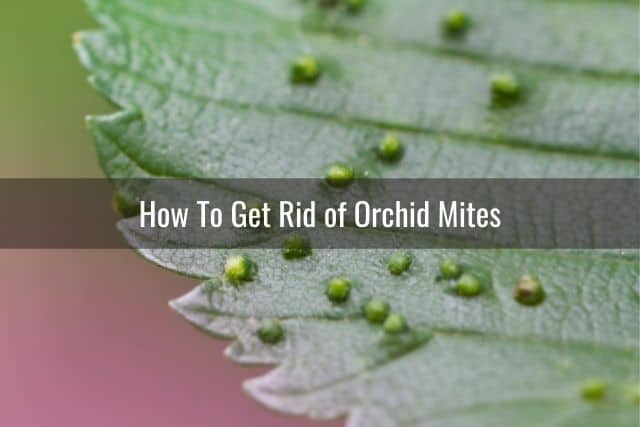
Unlike the previous two pests, mites are not insects. They are actually members of the arachnid family. Mites are closely related to spiders and ticks. Since they are nearly-microscopic in size, it is unlikely that you will ever see individual mites with the naked eye.
Identification Of These Orchid Pests
Instead, look out for signs of an orchid mite infestation through your plant. Mites will cause your orchid’s leaves to have a silvery shine underneath their leaves. This is where the mites have killed the surface layer and caused a lack of sap.
Just like with spiders, mites will leave webs on your orchid. While you may not be able to see the mites, you should be able to see the webs.
Mist the leaves with water and hold your orchid to the light. You should be able to see any webs, and if you are lucky, even a mite or two.
If you are still unsure if your plant has mites, try rubbing a white cloth along the back and front of a leaf. If you see reddish-brown streaks, these may be mites or their eggs.
Causes
Mites thrive in hot, dry climates. Therefore, orchids placed near sunny windows may be vulnerable to mite infestations. Orchids planted outside in warm climates will also be at higher risk for mite infestations.
Dry orchids, or orchids living in low humidity conditions, are also vulnerable. As a preventative measure, make sure you maintain adequate humidity levels for your orchid or keep it in a greenhouse. That is one way you can avoid an infestation. If possible, keep your orchids at a slightly cooler temperature as well.
I strongly recommend using a hygrometer to monitor humidity and temperature levels in and around your orchid’s growing area. This handy tool is fairly inexpensive and is a must for any serious orchid grower.
Treatments
Before performing any mite treatment on your plants, it is crucial to get all of the webs off.
Webs prevent topical treatments from reaching the plant, rendering any treatment attempts ineffective. Once you have removed the webs, treat the mites themselves through these methods:
- Homemade Solutions: You can easily DIY a mite removal spray. Any combination of water, dish soap, rubbing alcohol, and vegetable oil should do the trick. Wipe the liquid across the leaves once a week for at least three weeks. Regular treatment will ensure that you have eliminated any new mites that may have hatched.
- Special Mite Control Chemicals: Unlike many other white bugs, most insecticides do not really work on mites. However, if you have an especially large infestation, specialty mite control chemicals may be your only option. Look for acaricides or miticides at your local garden store. Make sure to check the chemical treatment is orchid-safe. It should say on the bottle. If you are not sure, test the product on a single area or plant before spraying it all over.
- GrowSafe makes an organic, natural miticide, fungicide and insecticide that is safe for orchids.
For more information, check out this detailed guide to how to get rid of spidermites on orchids.
How To Get Rid of Orchid Scales
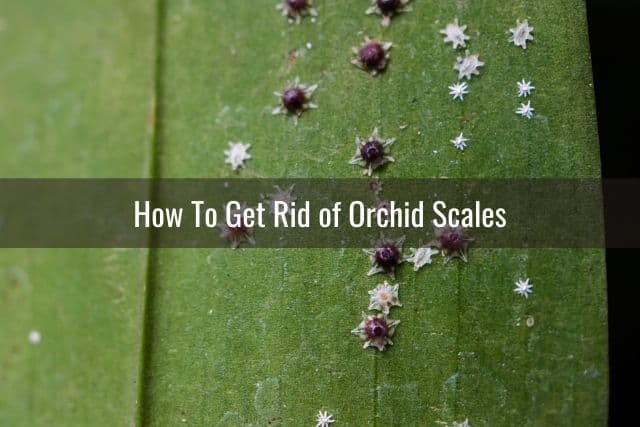
The scale is more damaging for orchids than almost any other pest. Very similar to mealybugs, scale is a sucking insect that latches onto the plant.
Identification Of These Orchid Pests
There are twenty-seven varieties of scale that all look different. It may be initially difficult to identify this pest unless you are already familiar with it.
One of the most common varieties, however, is the white wax scale. This appears as patches of white, waxy clumps on orchid shoots and stems. The scale also commonly presents as raised brown bumps on the plant.
You will likely notice that the plant is not looking its best. It won’t be until later that you see the hard patches on your orchid indicating a widespread scale infestation.
Initially, scale infestation is characterized by yellowed leaves and sagging, prematurely dropping leaves. This is because, like other common orchid pests, scale destroys the plant by sucking its sap. This leaves the plant dry, brittle, and vulnerable.
Scale bugs also secrete honeydew, just like their mealybug relatives, and suffer from the resulting complications.
Causes
As with most white bugs, the scale is usually caused by bringing an infected plant into your garden. These pests are extremely active and do not stay in one place for too long. They will crawl from plant to plant and hide in crevices.
Furthermore, air currents in greenhouses or indoor spaces help transport scale to other plants. Once the scale lands on another plant, it will begin to feast on the new plant’s nutrient-rich leaves.
Treatments
As with all the preceding pest treatments mentioned, a simple spray of water should be sufficient. However, this would only work if the infestation has not yet progressed too far.
You should be able to simply scrape the infected areas off by hand once they have been moistened. For more advanced cases, however, consider:
- Shaved Soap: Add shaved ammonia-free soap to warm water. Use this mixture and take the time to thoroughly clean all affected plants by hand. This may be the little extra effort your orchid needs to beat a scale infestation. Make sure to keep up the routine every day for a month.
- Neem Oil: You can use neem oil to kill many orchid pests, including scale. To learn more, see this article on how to use neem oil to treat common orchid pests, including how to dilute and prepare neem oil solution.
- Rubbing Alcohol: Just like with the mealybug, a scale infestation can be treated with rubbing alcohol. As before, remember to do at least two rounds of cleaning and inspection. This will ensure that you have gotten rid of both hard scaly areas and softer, discolored areas.
If you’d like to learn more, I’ve written a detailed guide on orchid scale. Check out this Everyday Orchids’ guide on how to get rid of scale from your orchid for an in-depth look at this orchid pest.
How To Get Rid of Orchid Thrips
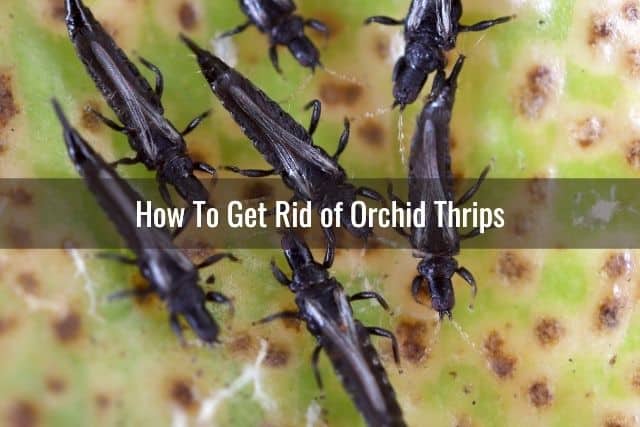
Thrips are slender, winged, sucking insects. These insects are especially attracted to white and other light-colored blossoms. Unfortunately, this makes orchids the perfect target.
Identification Of These Orchid Pests
Somewhat similar to aphids, thrips feed off a plant’s sap, piercing the surface of the plant with their mouths. Thrips are too small for you to easily detect with the naked eye.
Oftentimes, you will identify a thrip infestation based on the damage found on the orchid.
For example, you may see your orchid’s blooms becoming prematurely brown. The orchid’s leaves will start wilting and dropping. Overtime, the leaves will develop silvery streaks and chlorotic spots.
If you suspect your orchid has thrips, gently shake the orchid bloom over a white piece of paper. This will allow you to see if any narrow dark specks fall out. If this happens, you likely have a thrip infestation.
You can also add an insect sticky trap to your plant or place the trap near your plant. This will allow you to catch any flying thrips or other insects.
Causes
Thrips are a fairly common pest. It is possible that the infestation in your orchids is due to an infestation in a nearby host plant. Common host plants include onions, carrots, and squash.
Thrips spread most easily in unmaintained gardens with high grasses. These tall grasses have many places for the pests to breed and grow.
Since thrips are winged insects, they can easily move from plant to plant. As such, they can quickly infect an entire garden or greenhouse regardless of how well it is maintained.
Treatments
Again, starting with warm water and a mild soap is always the best course of action. With larger infestations, more aggressive remedies include:
- Pesticides: Insecticidal soap, acephate, and malathion are all good options. However, it is crucial to change up whichever treatment method you choose. This is because thrips can become resistant to chemical pesticides over time. Alternating between at least two treatments should avoid this.
- Mites: While it may seem counterintuitive, another option is to use predatory mites as a form of biological control. The female Amblyseius cucumeris mite lays eggs into thrips. When the eggs hatch, they kill the hosts. This might not be the best tactic for beginners, though. You will need to manage the mites so you do not end up with a mite infestation as well. That said, if you can manage the predatory mites, this method should be quite effective. If you employ predatory mites, however, make sure not to also use any pesticides.
For more information, check out this detailed guide on how to get rid of thrips from orchids.
How To Get Rid of Orchid Whiteflies

Whiteflies behave much like the other orchid pests I have covered on this list. They are small sucking insects that destroy plants by attaching to leaves, buds, and other nutrient-rich areas. They destroy the plant by sucking out the sap.
In addition to producing honeydew that can lead to damaging fungi, whiteflies are the natural prey of ants. If you have a whitefly infestation, you can expect even more ants around your orchids.
This would be even more ants than if the ants were just there for the honeydew a pest creates. So unfortunately, on top of a whitefly infestation, you might also get an ant infestation.
Identification Of These Orchid Pests
Signs of a whitefly infestation include white dotting on the underside of an orchid’s leaves, unhealthy new growth, mottled leaves, and the increased presence of ants.
Whiteflies will swarm when disturbed. The most telltale sign of an infestation is a cloud of tiny white insects that suddenly appear when you touch your orchid.
It is difficult to see individual whiteflies. However, you will be able to see this swarm and know you have an infestation.
Causes
Whiteflies are similar to both aphids and scales, spreading in the same way. An infestation in one plant can quickly spread to dozens of others. This is especially true in closed environments with air currents, such as greenhouses.
Many of the most popular plants you see in gardens are excellent hosts for whiteflies. These plants include hibiscus, gerbera daisy, tomato, chrysanthemum, and lavender. Whiteflies can easily travel from these plants to your orchid collection.
Treatments
In addition to horticultural oils and systemic insecticides, whitefly infestations can be treated with:
- Fungus: Introducing specific types of fungi to your garden can help to get rid of whiteflies. Beauveria bassiania weakens the whiteflies’ immune system, eventually killing them and preventing future infestations. You can also use fungus brands like Naturalis O and Botanigard.
- Biological Control: Introducing predators to your garden and letting nature run its course is another option. You can use predators like praying mantises and ladybugs to eat the bothersome whiteflies. These predators will then leave when the infestation/food is gone.
Unfortunately, although a natural predator of the whitefly, ants will continue to hang around the plant and cause additional damage. You will need to deal with the ants separately.
Final Thoughts
Getting rid of white bugs and other common orchid pests does take some effort.
You will first need to identify the orchid pest you have. Once you do, getting rid of the orchid pests can be done with simple, affordable methods.
If you can, start with simple soap and warm water mixtures before graduating to rubbing alcohol or pesticides.
There are also natural approaches, like introducing predatory bugs. However, the best way to get rid of these orchid pests is to tackle the problem early on.
Don’t give the infestation a chance to reach an advanced stage. When you water your orchids each week, take the time to check for signs of infection. If you see any orchid pests, remove them as quickly as possible. Best of luck!
If you enjoyed this article, please pin it and share!
